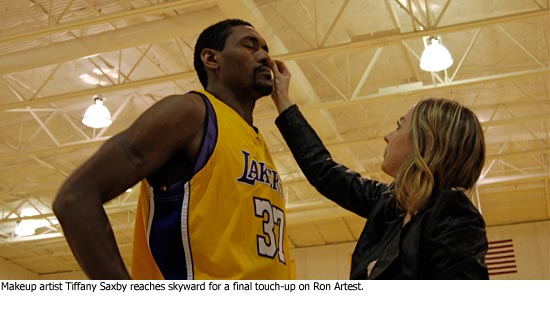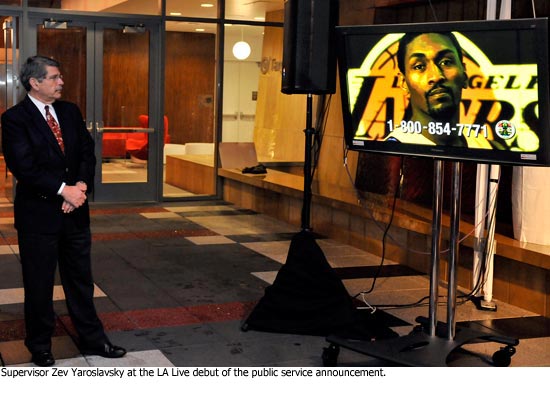A slam dunk for mental health
December 21, 2010

No doubt, millions of viewers nationwide thought Ron Artest was simply having another Ron Artest moment.
The NBA veteran had long been known for his slightly—or largely—off-kilter comments and behavior on and off the court, including a violent charge into the stands in Detroit and an appearance on Jimmy Kimmel Live! in just his boxers.
So when an ABC reporter asked the first-year Los Angeles Laker for a comment just minutes after he’d sparked his team to a Game 7 triumph over the Boston Celtics, he let loose with a winner. He thanked his psychiatrist.
Yes, it was indeed a Ron Artest moment—but one that he says was premeditated and timed for maximum impact to let people know—especially the young people out there—that therapy had helped him work through many difficult chapters in his life. “I was doing it for a good reason,” he says of his expression of gratitude. “I didn’t know what was going to happen but I wanted it to take off.”
And take off it did.
Artest’s remark quickly set in motion an unusual collaboration that led on Tuesday to the debut of a public service announcement from Los Angeles County’s Department of Mental Health. (See video below.) Called “You Can Do It,” the spot features Artest on the court and was produced by the Hollywood executive behind the movie “The Soloist,” the story of L.A. Times columnist Steve Lopez’s relationship with homeless musician Nathaniel Ayres.
Artest openly credits an array of therapists and counselors with helping him relax and mature during a career that, for a time, brought him more notoriety than respect. He’s seen marriage counselors and parenting experts and therapists who specialize in the pressure-packed world of professional sports.
Artest says he also knows from growing up in the rougher neighborhoods of Queens how easy it is to be swept up in the criminal life or to simply lose your way in a family that is broken or abusive. “Some kids,” Artest says, “aren’t as mentally tough.”
This is the audience that the player and the mental health department hope to reach in the public service announcement, filmed last month at the Lakers’ practice facility in El Segundo. (See photo gallery and extended video interview with Artest below.)
Orchestrating the effort for the county has been clinical psychologist Dr. Alysa Solomon. She says that the minute she heard Artest give a shout-out to his “psychiatrist” (actually a psychologist), she dove for her Blackberry to e-mail her boss, mental health director Dr. Marvin J. Southard. “I was overexcited,” she says. “It was a universal jaw dropping moment.”
For nearly two years, Solomon had been leading the mental health agency’s “social inclusion” campaign, underwritten by California’s so-called Millionaires’ Tax and aimed at ending the stigma that too often stops people from seeking the psychological help they need. One way to do that, she thought, was to recruit celebrities who’d be willing to be interviewed by her about their own mental health issues—new territory for a department steeped in a culture of confidentiality.
First up was actor Tom Arnold, who has spoken widely of his battle with drug addiction and his life in recovery. The interview was filmed but lawyers for the actor blocked it from being seen, Solomon says, because the legal paperwork didn’t make clear that the county could not profit from the effort. “Our county counsel is not an entertainment law firm,” she says. “But we learned the process.”
In the meantime, Solomon had begun developing a friendship with violinist Ayres, who by then was receiving services from the mental health department. Solomon thought Ayres and Lopez would be perfect for the anti-stigma campaign. So she reached out to “The Soloist’s” producer. In him, she found a kindred spirit and a savvy ally.
From the earliest days of “The Soloist’s” journey from a book by Lopez to the big screen, producer Gary Foster was committed to infusing it with a sense of authenticity by shooting scenes in the heart of Los Angeles’ Skid Row. Although Robert Downey Jr. and Jamie Foxx would be the marquee names, the supporting cast would be the people of the streets.
“We thought it would be wrong to just be the circus that came to town and exploit what was going on down there,” explains Foster, who says the movie’s real-life characters were paid for their performances.
Throughout the filming, Foster and others involved with the project spent days in the teeming courtyard of a Skid Row housing and mental health agency called Lamp Community. There, he got to know the human beings behind Los Angeles’ homeless statistics and their daunting challenges with mental health. After his movie disappeared from theaters, Foster remained passionate about ways to communicate the need for psychological care to sufferers in all strata of society. He took a seat on Lamp’s board.
When Solomon pitched her idea for public service announcements, Foster says, it was a natural—“a great way for me to use my skills to further the mission.” Among other things, he’d know who to tap for help, such as Mob Scene Creative + Productions, an award winning entertainment marketing company that would take the lead in making the PSA.
But the anticipated starting lineup would need to be changed, with Ayres and Lopez taking a seat on the bench, thanks to Artest’s out-of-the-blue post-game comment and a highly publicized appearance at an East L.A. school, where he encouraged the kids to seek counseling if they were having troubles in their lives.
“Ron fell into our lap,” says Solomon, who was thrilled because of the athlete’s natural appeal to a demographic the mental health department had targeted—young teenage boys who might be too embarrassed or afraid to reveal their psychological struggles.
By mid-September, a short script had been jointly created by officials in the mental health department and advocates in the community. They dreamed of hearing Artest say: “I got help and got better, you can get better too. Take that first step and be a champion!”
Foster and Solomon then sent an e-mail to Artest’s publicist and friend, Heidi Buech, saying they’d “be honored to have Ron participate in our PSA program.” Within 24 hours, he was on board.
“Here’s one of the most unique celebrities in Los Angeles sports and he’s brave enough to talk about his personal life,” Foster says. “I think it’s going to have great therapeutic effect.”
Artest, for his part, says the decision was easy.
“People need to be educated,” he says of those who denigrate the value of talking to professionals. “People think you’re crazy or weak but that’s not true.” More specifically, he says, “I’m trying to help build confidence and a support system for kids that don’t have one.”
Although he wanted to create a bit of a stir by thanking his Houston-based sports therapist after the NBA finals, he says he never intended to be “one of the faces of the movement.” He says he “inherited” it.
“Once I said what I said, it was like, wow!”
And there’s more to come.
On Christmas night, Artest will announce the winner of a raffle for his first and only championship ring. The proceeds from “Win My Bling,” which amount so far to almost $600,000, will go to a number of mental health charities and to Artest’s Xcel University, a foundation he established to help at-risk kids build self respect and overcome their difficult environments.
Then in February, he’ll be headed to Washington D.C. to testify on behalf of HR 2531, a bill sponsored by Rep. Grace F. Napolitano (D-Ca.) that is aimed at boosting mental health services in schools.
“It’s like going into the NBA,” he says. “I never dreamed I’d be in the NBA. And I never dreamed I’d be going to The Hill. Ever.”
And that’s something to talk about.
The Ron Artest/ Los Angeles County public service announcement.
http://zevyaroslavsky.org/videos/RAP_BeAChampion30_TEXTED_FINAL_HD-Fixed.f4v
An extended interview of Artest by Dr. Alysa Solomon of the mental health department.
A photo gallery from the PSA filming in El Segundo.
Posted 12/12/10























 405 bridge work causes a stink
405 bridge work causes a stink

